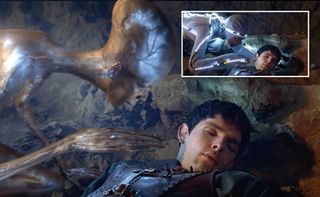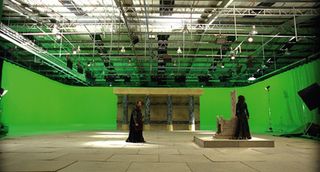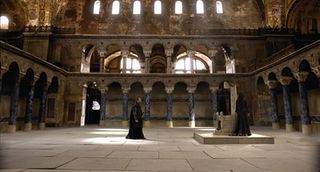Behind the scenes: Vine's 3D work for Merlin
Mark Ramshaw asks how you take over effects work for a hit show watched in 180 countries. For Merlin, Vine built a 3D facility from the ground up
Taking over an existing TV show is always a tricky proposition, what with a need to retain visual consistency, to integrate any handover assets into a different studio pipeline, and inevitably to raise the bar even higher. But for boutique Soho studio Vine - the vendor for season five of BBC flagship show Merlin - there was one further challenge: the studio had never even handled 3D before...
Vine was founded in 2007 by Michael Illingworth, a veteran of facilities like The Mill, Cinesite and the Harry Potter visual effects team at Leavesden. For the fourth series of Merlin, Vine effectively became the in-house matte painting department for its producers, Shine. Impressed by the quality of the work, Shine then asked if Vine could create a magical creature for the show’s fifth and final season.
“The producers then began to award more of the 3D work, until we effectively became Shine’s in-house VFX department,” says Illingworth. “In the end we handled all of the visual effects.”
Surprisingly, Illingworth says there wasn’t too much trepidation about Vine creating a full service facility: “I approached Claire McGrane, a postproduction supervisor with a lot of experience building teams and pipelines, to help plan how we should build it.”
Vine effectively had to start from the beginning with every aspect of the 3D pipeline, though Escape Studios was on hand to help choose and install the right hardware and software. “By setting up a facility from scratch we actually had the advantage of being able to choose the right tools for the job, instead of dealing with legacies from past shows,” says Illingworth.

He’s equally pragmatic about the task of taking over such a successful show: “We were given some of the assets and we used as much as we could, as we did not feel there was anything to be gained from reinventing the wheel. Things have moved on technologically since Merlin began so we changed some things to get a better result, such as using a render pipeline based on Arnold. But even here we re-used textures as much as we could.”
“We researched several rendering solutions and decided Arnold would give us the best results because of its speed and physically based rendering architecture,” explains 3D supervisor Ivor Middleton. “Maya provided the backbone of our pipeline, and we then freely dipped in to any other software available when it made the results faster and better.” Pre-production began in early 2012, and by April Vine found itself building and rigging two pivotal characters in the show: ancient humanoid creature The Diamair, and the young dragon Aithusa. “Over the following months the shot count increased, the shots became more complex, and we were then awarded the Great Dragon to animate as well,” says Middleton. “Fortunately we were able to use the model, textures and rig developed for it in the previous series, so we only had to build new shaders and set up a new facial animation pipeline.”
High expectations
Illingworth says the fact that they were given Harry Potter and the Deathly Hallows as a reference for the design of Aithusa let them know expectations were high. The intention with Martin Rezard’s design was to move away from traditional fantasy dragon designs, and instead give her a more realistic appearance. “She had been in a lot of fights since her birth at the end of season four,” says Middleton. “Virgil Manning led the dragon animation team. He based the walk on a Great Dane, to give her a loping, dogged motion. The trickiest thing to get right and maintain across all the shots was her limp. Once she took flight we then used a Bald Eagle as inspiration.”

The wisp-like Diamair proved more difficult. She is a 400-year old humanoid creature, and she needed to be skinny, naked, and translucent with light-emitting skin. “We based her light-emitting characteristics on deep sea creatures and took inspiration from the internal organs of jellyfish and similar animals, creating regions of moving detailed wrinkly ‘stuff’ within her,” says Middleton. “These organs moved with her body, but also had independent activity to create a feeling of her life forces glowing through.”
Illingworth believes that the studio’s size and structure has worked to its advantage when tackling the work for Merlin. “It’s run by creatives, so there isn’t the baggage you get with a larger facility, which allows us to be flexible and adaptable as changes are needed in storylines.”

Operating as Shine’s in-house visual effects team has also given the studio a unique relationship with the show’s creators. “They are willing to make editorial cuts if a sequence is a little too ambitious, and likewise if they need to expand a sequence and we already have the assets built then we can easily shift our resources to provide extra shots without any financial implications,” notes Illingworth. “This kind of two-way relationship is crucial for television projects, especially with last minute script changes and other shifts.”
From its starting point as a small 2D crew, Vine has ultimately provided some 720 shots across 13 episodes for season five of Merlin, ranging from scenes with fully digital hero creatures through to digital doubles, 3D butterflies, swords and daggers, plus dynamic effects and multiple set extensions and mattes. “I don’t think we could have achieved this type of work five years ago, but it’s the availability of off-the-shelf solutions like Shotgun, Revolver, Deadline, RV, Agisoft and Arnold that have all made it possible,” says Illingworth. “We’re a small team - most of us from a film background - and I do think what we’ve achieved with the resources available has been pretty amazing.”
Discover the best 3D movies of 2013.

Thank you for reading 5 articles this month* Join now for unlimited access
Enjoy your first month for just £1 / $1 / €1
*Read 5 free articles per month without a subscription

Join now for unlimited access
Try first month for just £1 / $1 / €1
Get the Creative Bloq Newsletter
Daily design news, reviews, how-tos and more, as picked by the editors.
The Creative Bloq team is made up of a group of design fans, and has changed and evolved since Creative Bloq began back in 2012. The current website team consists of eight full-time members of staff: Editor Georgia Coggan, Deputy Editor Rosie Hilder, Ecommerce Editor Beren Neale, Senior News Editor Daniel Piper, Editor, Digital Art and 3D Ian Dean, Tech Reviews Editor Erlingur Einarsson and Ecommerce Writer Beth Nicholls and Staff Writer Natalie Fear, as well as a roster of freelancers from around the world. The 3D World and ImagineFX magazine teams also pitch in, ensuring that content from 3D World and ImagineFX is represented on Creative Bloq.
